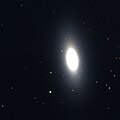| | This section needs expansion. You can help by adding to it. (December 2025) |
| NGC 4033 | |
|---|---|
 Hubble Space Telescope image of NGC 4033 | |
| Observation data (J2000 epoch) | |
| Constellation | Corvus |
| Right ascension | 12h 00m 34.7473s [1] |
| Declination | −17° 50′ 33.405″ [1] |
| Redshift | 0.005394 [1] |
| Heliocentric radial velocity | 1617 km/s [1] |
| Distance | 73.73 ± 4.34 Mly (22.606 ± 1.331 Mpc) [1] |
| Apparent magnitude (V) | 13.18 |
| Characteristics | |
| Type | E6 [1] |
| Apparent size (V) | 2.25′ × 1.1′ [2] |
| Other designations | |
| PGC 37863, MCG -03-31-011 [1] | |
NGC 4033 is an elliptical galaxy located in the constellation Corvus. [2] It was discovered on 31 December 1785, by William Herschel.


